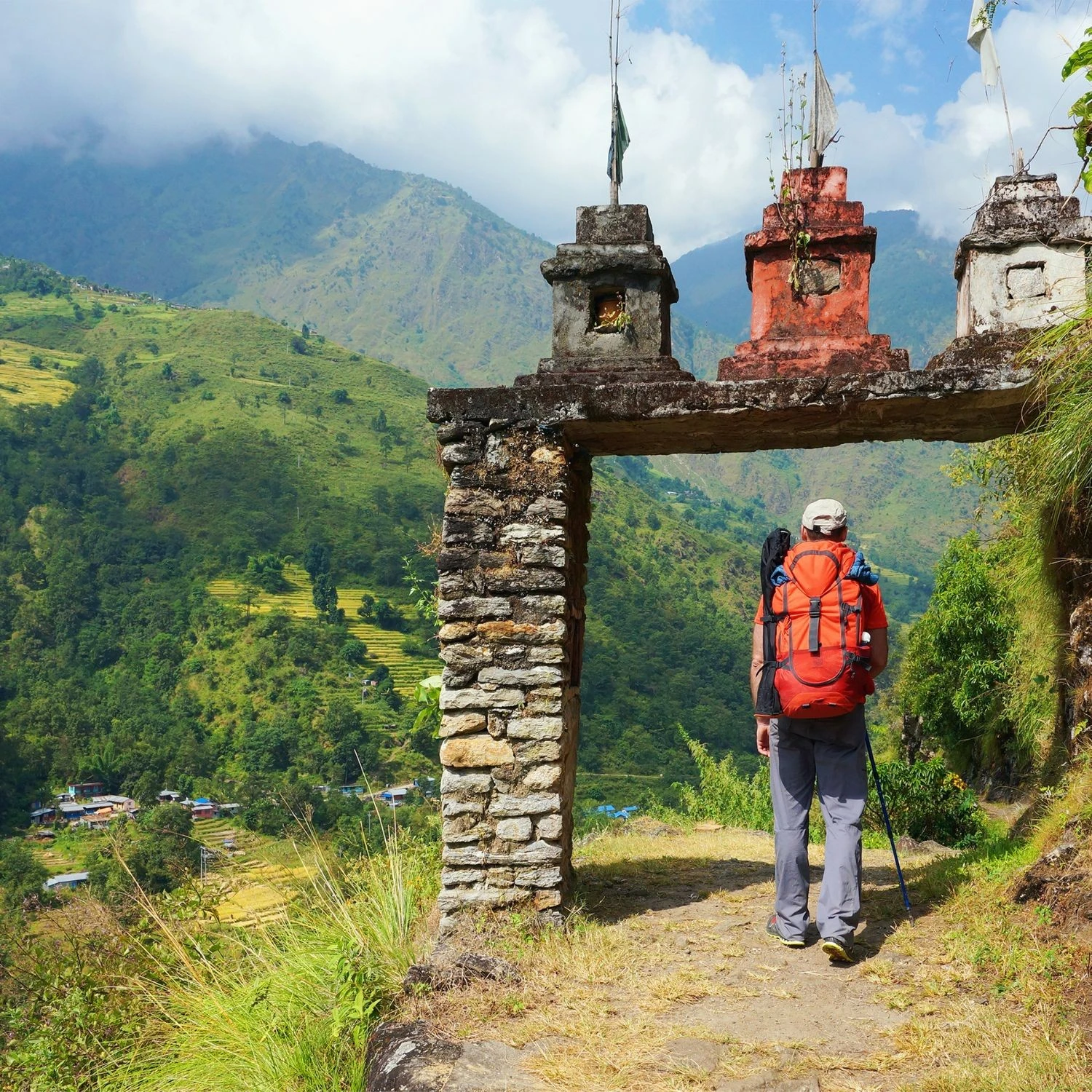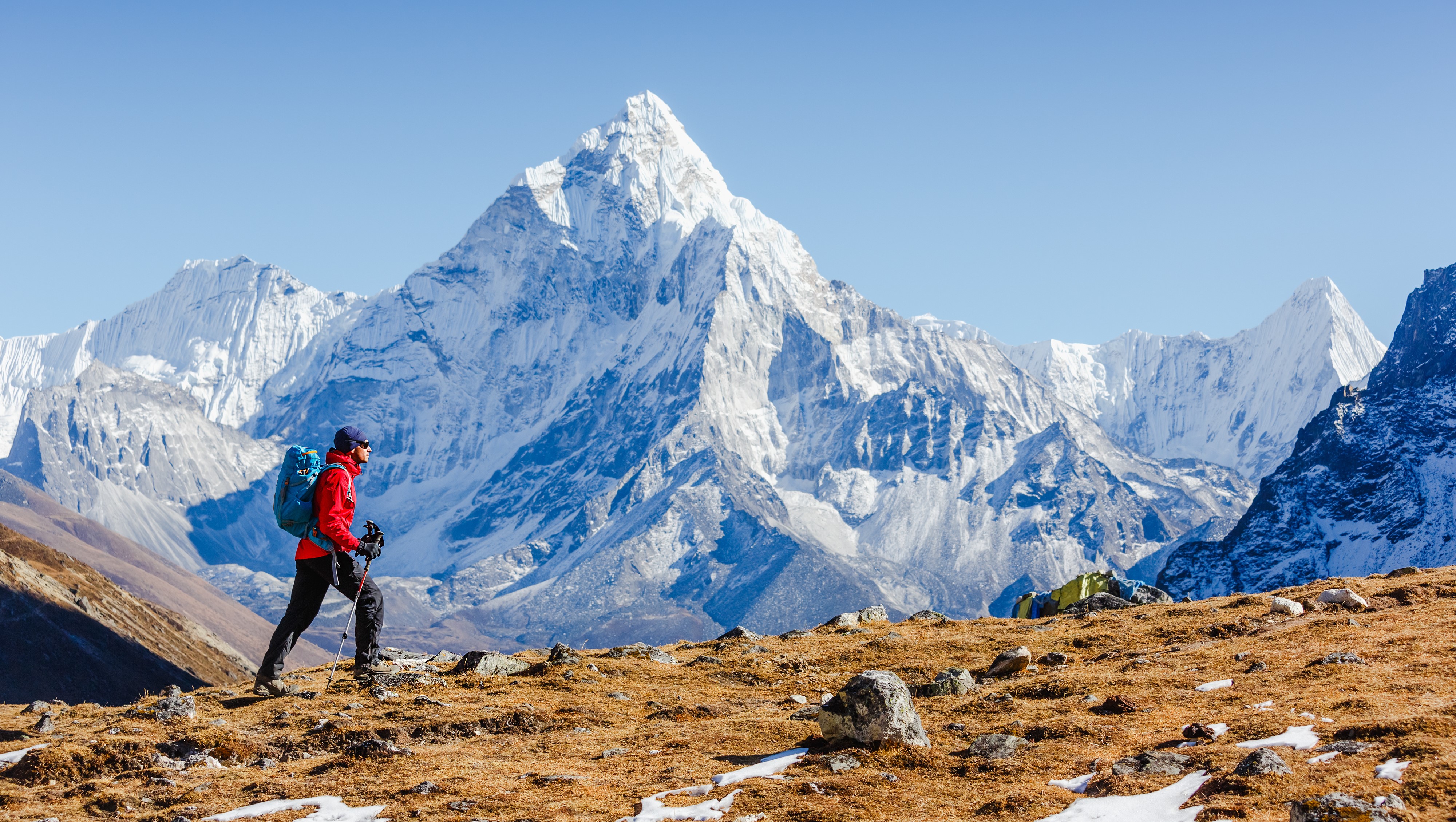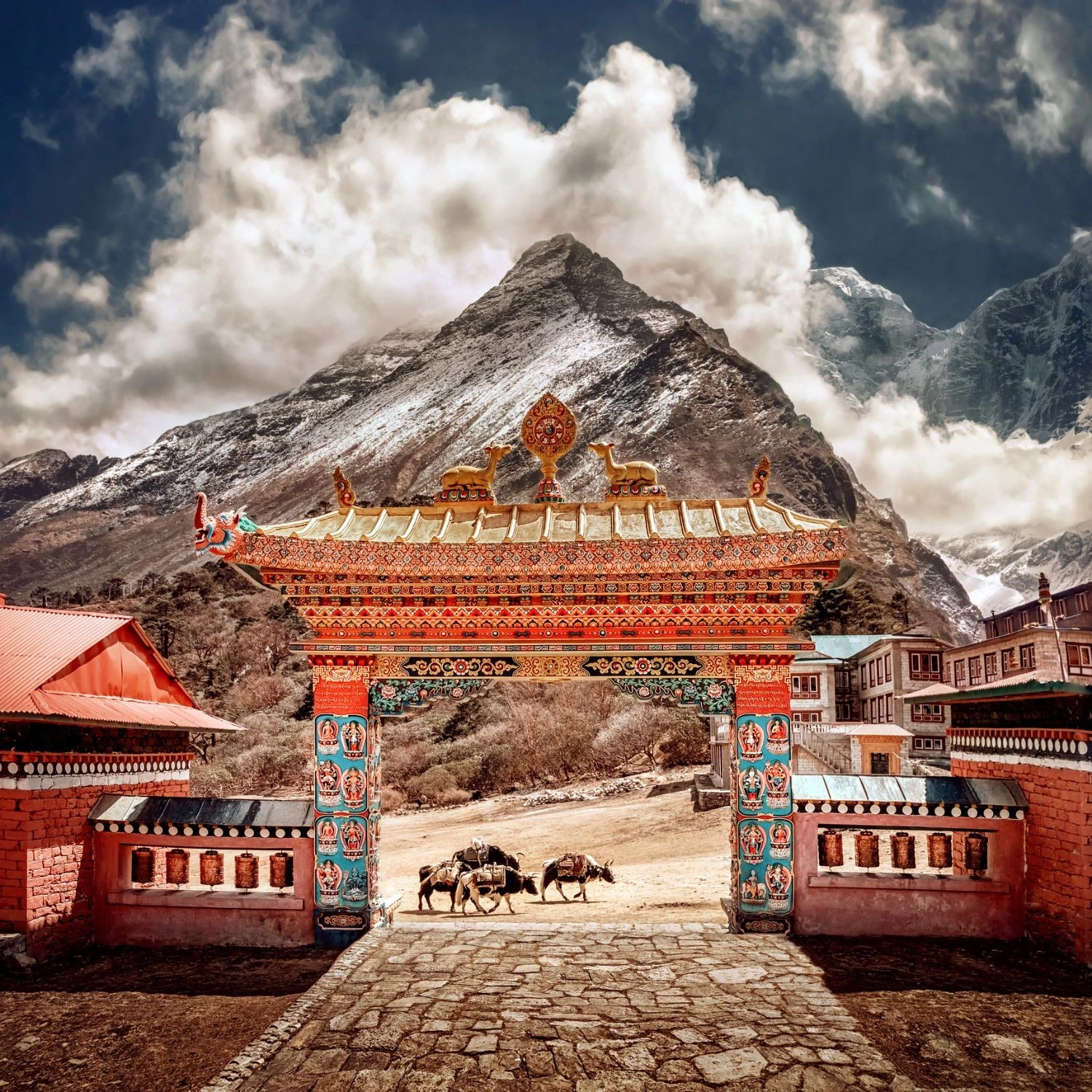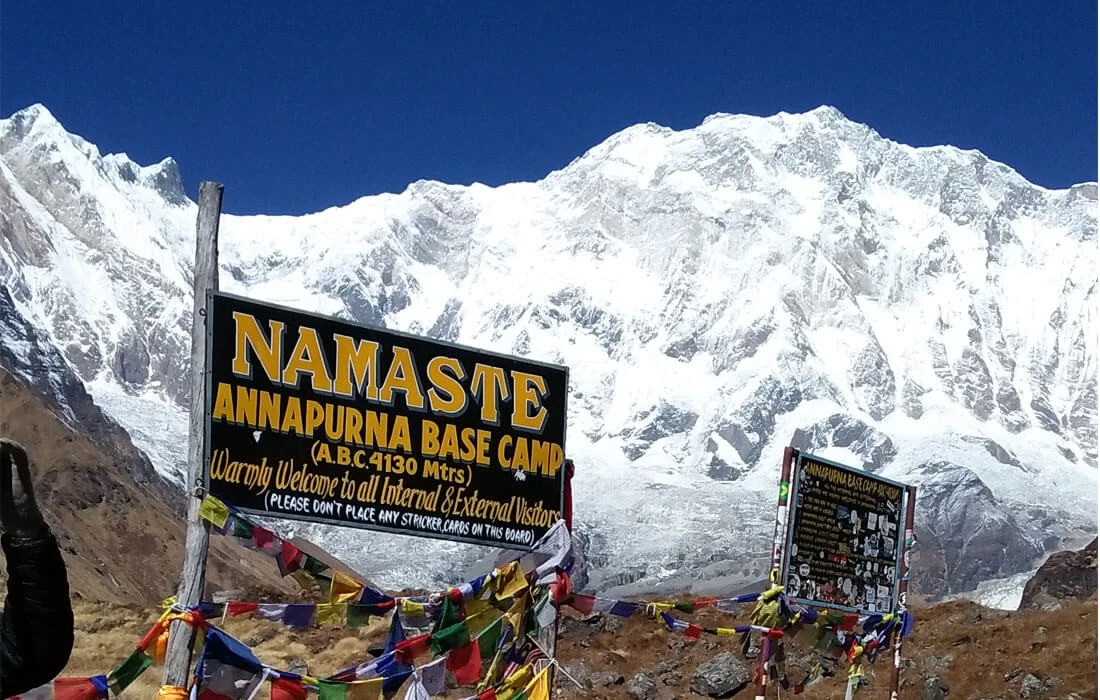Difficulty
Challenging
Duration
16 Days
Max Elevation
5550m
Group Size
2-12
Accommodation
Good quality hotels, teahouse lodges during days on trek.
Type of trip
Trek
Transportation
Private transfers by car or minibus, flight to and from Lukla
Start / End
Kathmandu, trek from Lukla
Enjoy the legendary Everest Base Camp Trek, one of the world’s most iconic high-altitude adventures. This journey takes you through the heart of the Himalayas, offering breathtaking mountain scenery and panoramic views of peaks like Everest, Lhotse, and Ama Dablam. Starting from Lukla, the EBC trek winds through the stunning landscapes of Sagarmatha (Everest) National Park, passing through lush forests, rolling meadows, and glacial moraines.
The Everest Base Camp trail is a cultural and natural wonder, allowing you to experience the rich traditions of the Sherpa people while trekking through picturesque villages and verdant valleys. Reaching Everest Base Camp, at an altitude of 5,364 meters (17,598 feet), is a life-changing achievement. Stand in the shadow of Mount Everest (8,848 meters/29,029 feet) and soak in the awe-inspiring beauty of the Khumbu Valley.
The trek to Mt Everest base camp requires a moderate level of fitness, as the trail includes steep ascents, descents, and high-altitude hiking. Perfect for adventure enthusiasts, the Everest Base Camp Trek Nepal promises unforgettable memories and a deep connection with the Himalayas.
Join the Mount Everest Base Camp trekking adventure and experience the magic of the world’s highest peak. This is more than a trek—it’s a journey of a lifetime.
Welcome to Nepal. Once through immigration and baggage collection, head to the meeting area outside the airport where you'll be met by one of our local team for the transfer drive to your hotel. After time to rest and get refreshed, you'll have an informal briefing and overview about the local area and your trek plus a chance to ask any questions. This evening we invite you to enjoy a complimentary welcome dinner at one of the finest traditional Nepalese restaurants in Kathmandu. Overnight Kathmandu.
This morning you'll meet your trekking guide who'll brief you on your trek and answer any questions you may have and there's time for any last minute trek preparations or local purchases. Then it's time for the drive to Ramechhap where you'll stay overnight before your flight to Lukla tomorrow morning. It's around a 4-5 hour fairly scenic drive. After arrival the rest of your day is free to rest and relax, ready for your trek starting tomorrow. Overnight Ramechhap.
After crossing the suspension bridge over the Dudh Koshi, the walk is pleasant, with a few short ascents and descents, until we re-cross the Dudh Koshi river from the village of Benkar, taking in the magnificent views of Thermasarkhu peak (6608 m). We then cross the long suspension bridge over the Bhote Koshi river to reach Monjo village, situated below the spectacular peak of Thermasherkhu and a few minutes' walk from the entrance to Sagarmatha (Everest) National Park. At the entrance to Sagarmatha National Park, your trekking permit will be checked, as the National Park keeps a record of all trekkers in the area. From here, a short descent brings us to another suspension bridge over the Bhote Koshi river, after which we reach a bridge to Jorsalle village, the last village and the only place to shop until we reach Namche Bazaar, so a good place to get any additional snacks if needed. The walk from Jorsalle village is pleasant, following the river until coming to the last bridge over the Imjatse river. The walk to Namche Bazaar traces a winding, uphill path, with a magnificent view of Kwangde Peak and its other sister peaks towards the east and Kusum Kangru to our back. As we climb higher, we'll be able to see the Mount Everest- Nuptse wall, Lhotse, and Taweche Peak, all the way up to Thop Danda, where there is a stone wall for porters and trekkers to rest on. From here, another 1-2 hour trek takes us to famed Namche Bazaar, where the colorful houses are situated in an amphitheatre style. Evening at leisure. Overnight at a local teahouse lodge.
This is a day to rest and acclimatise before we trek to higher altitudes tomorrow. Relax at the teahouse or explore the local area. Suggested activities include taking the short walk uphill to the Sagarmatha National Park Headquarters, a magnificent spot perched on top of Namche Bazaar, with breathtaking views of the surrounding snow-capped giants and the deep valleys below. There is also an interesting museum telling of the history of the Himalayas, the geographic information of the area and local cultural practices, mountaineering history, and the flora and fauna of the region. Full day at leisure and overnight at the teahouse lodge.
After breakfast, the trail leads down a good, winding path with spectacular views of Mount Everest, Lhotse and Nuptse to the north east, Ama Dablam to the east, Kangtenga and Thermasarkhu to the southeast and Kwangde to the south. After a few hours trek, the path descends towards Fungi Thenga, where we'll stop for lunch. After lunch, we ascend through a beautiful forest of pine and rhododendron trees before reaching Tengboche after around two hours. Here we'll take time to visit Tengboche Monastery with your guide. Thyangboche (also spelt Tengboche) is one of the most beautiful places in the Himalayas. The first thing we'll see is the monastery (also known as a gompa), then a large field with the campsites, teahouses, and lodges beneath the towering, majestic peak of Ama Dablam, with Everest looming above, the Nuptse wall to the north, and Mount Lhotse and Lhotse Shar to the northeast. Enjoy your evening at leisure, surrounded by amazing peaks. Overnight at local teahouse lodge.
Leaving Tengboche (also known as Thyangboche), the trail descends through a forest of birch, fir, juniper, and rhododendron, before it finally reaches Debouche, a lovely spot situated at 3650 m, with magnificent views of Ama Dablam, Everest, Nuptse and Lhotse. From Debouche, the trail meanders past a long prayer Mani wall. The path is gradual until we reach a small bridge over the narrow gorge of the Imja-Tse river. From here, it is a gradual ascent most of the way to Pangboche village. Lush vegetation vanishes as we gain altitude. After Pangboche, it is a short climb to Shomare where we stop for lunch. Shomare is a small settlement with a fantastic view of Ama-Dablam. From here, we can see the northern face of Kangtenga peak. After lunch our journey continues gradually towards the east. After around an hour's trek, just before a small wooden bridge, the road splits in two directions, going towards Pheriche or towards the east, where we'll head. From here, we'll be able to see a totally different view of Ama Dablam, its towering north face. From the bridge, the trail climbs slowly, winding above the Imjatse river, until we arrive at a big Mani stupa. From here onwards the route is fairly moderate as it enters the Imjatse Valley beneath the mighty peaks of Ama Dablam, Nuptse, and Lhotse with a view of the eastern snow-capped mountains, including Island peak or Imjatse (6189 m). Dingboche is situated amongst a beautiful patchwork of fields enclosed by stone walls, which protect the crops of barley, buckwheat, and potatoes from the cold winds and grazing animals. Dingboche has about ten teahouses and it is also the gateway to Chukung. Evening at leisure and overnight at a local teahouse lodge.
Today is a full day to rest, acclimatise and take time to explore this part of the Khumbu region. If you are feeling energetic, you can take an optional trek towards Chhukung and back, or simply hike to the top of the hill for the views of Makalu and other surrounding peaks. Explore the hidden Imjatse Valley with its awesome views. This afternoon we'll have a briefing from the Himalayan Rescue Association about high altitude sickness and what to look out for. Overnight at a local teahouse lodge.
From Dingboche, the trail now heads towards the north. The path is gradual for about 40 -50 minutes before we reach the Mani prayer stupa. From here the trail is gentle, overlooking Pheriche village. Today's trek offers beautiful views of Mount Taweche and Ama Dablam and, to the north, Pokalde (5741 m), Kongma-tse (5820 m), and the great wall of Nuptse. After a pleasant trek of around 1 1/2 to 2 hours, the trail from Pheriche joins Dugla right before a small wooden bridge over the rushing river of Khumbu glacier. Dugla is the only place with tea houses before Loboche. From Dugla, a steep one-hour ascent brings us to the top, where we can view Mount Pumori, as well as the other peaks west of Everest. This is an ideal spot for a short break after the strenuous climb. Close to here we will also see a number of memorials for the climbers who sadly perished in expeditions in the mountains of this region. From here, it’s a 1 1/2 to 2 hours gradual ascent before we arrive at Loboche. Loboche comes as a surprise, as it's situated in a corner well-hidden and sheltered from the wind, with just a handful of teahouses. Overnight in a local teahouse lodge.
It's a good easy trail from Gorakshep to Everest Base Camp as the trail ascends and descends along glacial paths. We follow the trail as it meanders past huge rock boulders until we reach historic Everest Base Camp. Here, standing at the foot of mighty Everest, we can also enjoy magnificent views of Nuptse, Khumbutse, Pumori and the other Everest range of mountains visible from Base Camp. After a short sightseeing at Base Camp we return back to Gorakshep where we rest for the night. Overnight at local teahouse lodge.
This morning it's an early start as we hike up to the Kalapathar viewpoint for more magnificent views of Everest. A fairly easy trail leads us to the top of Kalapathar, which translates as 'Rocky Mountain' in Nepalese. Enjoy the close up views of the world’s tallest mountain along with the other mighty Himalayan peaks that surround Everest. After spending some time at the summit of Kalapathar, we trek back to Gorakshep before making our way towards Pheriche where we'll rest tonight. Overnight local teahouse lodge.
The trail from Pheriche descends towards the Imja Khola river, crossing a bridge. We follow the gradual trail to Debouche for around an hour, then from Debouche the trail climbs for around forty minutes to reach Tengboche. From Tengboche the route then steeply descends to Phunki Thangka through the pine and rhododendron forest before ascending to the ridge, passing some small villages and joining at Shanasha and Kyanjuma. Around another two hours trek brings us to Namche Bazaar. Overnight at a local teahouse lodge.
This is our last day on trek and we'll take it leisurely to make the most of the beautiful scenic views and surrounding landscape. Apart from a few short uphill sections, the only long climb today will be just before Lukla, when the trail climbs for around 45 minutes from a place called Choplung. Reaching Lukla, there's time to rest, relax and explore the local area before a final dinner with your Sherpa crew and porters. Overnight at a local teahouse lodge.
This morning it's time for the short flight, around 20 minutes, back to Ramechhap. Flights from Lukla are usually scheduled in the morning as in the afternoon the wind usually picks up and can cause delays. Enjoy the panoramic views of the snow-capped peaks during your flight. Arriving at Ramechhap, it's time for the scenic transfer drive of around 4-5 hours back to Kathmandu. After checking in to your hotel, the rest of your day and evening is at leisure to rest, relax, explore the local area and celebrate your achievement of reaching iconic Everest Base Camp! Overnight at your hotel.
Today is a chance to explore some of the key cultural and heritage sites of Kathmandu. After your breakfast, you'll be met by your guide before heading to nearby Kathmandu Durbar Square, an impressive World Heritage Site and hugely important place in Nepalese history and culture. You'll be able to visit the ancient palace complex and the temple of the Living Goddess of Nepal , the Kumari. You'll also visit Hanuman Dhoka and Kasthamandap Temple. From here, we'll drive to Pashupatinath Temple, the holiest shrine for Hindus, situated on the banks of the holy Bagmati River and an important cremation site. We'll also visit Boudhnath Stupa, an important Tibetan Buddhist pilgrimage site and the centre of Tibetan pilgrimage in Nepal. The huge stupa is one of the largest dome stupas in the world and is surrounded by many small monasteries, shops and cafes. We'll also visit Patan, also known as the City of Fine Arts, just outside Kathmandu City where you'll be able to explore the spectacular Durbar Square and beautiful temples and palaces. After time to explore, we'll return to your hotel where the rest of your evening is at leisure to rest and relax, explore locally and do any last minute shopping before your departure tomorrow.
This morning is free until time to check out and your transfer to the International Airport for your departure flight home or onward to your next destination. If you'd like to extend your trip there are plenty of options including wildlife safaris, white water rafting, mountain biking or perhaps a visit to the neighbouring regions of India, Bhutan or Tibet - ask us for details and we'll be happy to help.
Join this fantastic bucket list trek to reach historic Everest Base Camp at the foot of the world's highest peak, mighty Everest. Choose from one of our small group treks below or contact us to book a private trek based on your preferred dates.
| Dates | Price | Deposit | |
|---|---|---|---|
|
September 30, 2025 October 15, 2025 SAVE £150 when you book before 31 August 2025. |
£2395 | £250 | Book this Trip |
|
October 3, 2025 October 18, 2025 SAVE £150 when you book before 31 August 2025. |
£2395 | £250 | Book this Trip |
|
October 10, 2025 October 25, 2025 SAVE £150 when you book before 31 August 2025. |
£2395 | £250 | Book this Trip |
|
October 19, 2025 November 3, 2025 SAVE £150 when you book before 31 August 2025. |
£2395 | £250 | Book this Trip |
|
October 26, 2025 November 10, 2025 SAVE £150 when you book before 31 August 2025. |
£2395 | £250 | Book this Trip |
|
November 2, 2025 November 17, 2025 SAVE £150 when you book before 31 August 2025. |
£2395 | £250 | Book this Trip |
|
November 16, 2025 December 1, 2025 SAVE £150 when you book before 31 August 2025. |
£2395 | £250 | Book this Trip |
|
November 30, 2025 December 15, 2025 SAVE £150 when you book before 31 August 2025. |
£2395 | £250 | Book this Trip |
|
December 5, 2025 December 20, 2025 SAVE £150 when you book before 31 August 2025. |
£2395 | £250 | Book this Trip |
|
December 16, 2025 December 31, 2025 Celebrate Christmas Day at Everest Base Camp! |
£2395 | £250 | Book this Trip |
|
December 23, 2025 January 7, 2026 Celebrate Christmas on trek and New Year at Base Camp! |
£2395 | £250 | Book this Trip |
| Dates | Price | Deposit | |
|---|---|---|---|
|
March 1, 2026 March 16, 2026 |
£2495 | £250 | Book this Trip |
|
March 15, 2026 March 30, 2026 |
£2495 | £250 | Book this Trip |
|
March 29, 2026 April 13, 2026 |
£2495 | £250 | Book this Trip |
|
April 5, 2026 April 20, 2026 |
£2495 | £250 | Book this Trip |
|
April 19, 2026 May 4, 2026 |
£2495 | £250 | Book this Trip |
|
April 26, 2026 May 11, 2026 |
£2495 | £250 | Book this Trip |
|
October 4, 2026 October 19, 2026 |
£2495 | £250 | Book this Trip |
|
October 18, 2026 November 2, 2026 |
£2495 | £250 | Book this Trip |
|
November 1, 2026 November 16, 2026 |
£2495 | £250 | Book this Trip |
|
November 8, 2026 November 23, 2026 |
£2495 | £250 | Book this Trip |
|
December 6, 2026 July 14, 2025 |
£2495 | £250 | Book this Trip |
|
December 13, 2026 December 28, 2026 |
£2495 | £250 | Book this Trip |
The best time for the Everest Base Camp Trek Nepal is during the spring (March to May) and autumn (September to November) seasons. These months offer clear skies, stable weather, and the best views of Mount Everest and the surrounding peaks. If you prefer quieter trails, December and February are also good times with fewer trekkers generally at these times of year.
The EBC trek is considered challenging in difficulty. It involves steep ascents, descents, and high-altitude hiking of around . A reasonable to good level of fitness and preparation is recommended for the Everest Base Camp trail.
The fitter and better prepared you are the more you will enjoy the Everest Base Camp trek. We recommend training 3 to 4 times per week, at least several months before your trek, focusing on leg strength, endurance and overall cardiovascular fitness. Cycling, hiking, hill walking, running and stair climbing are all great options to help you prepare.
Everest Base Camp is located at an altitude of 5,364 meters (17,598 feet). Proper acclimatisation is essential to avoid altitude sickness during the trek to the base camp Mt Everest. All our treks are carefully planned to include appropriate rest and acclimatisation days for a safe and enjoyable trekking experience.
Pack warm clothing, sturdy hiking boots, a sleeping bag, sunscreen, sunglasses, and a first-aid kit. Layering is key due to varying temperatures on the Mount Everest Base Camp trekking route. When you book with us, we provide a suggested list of clothing and equipment specific to your booking.
Yes. Most teahouses provide hot showers, although in the higher parts of the trail, shower and other facilities are more basic and hot showers might not always be available, especially if arriving later in the day. Most lodges charge a small fee for hot showers. Some trekkers prefer to minimise taking showers at the higher altitudes due to the more basic facilities and the colder temperatures.
Most of your costs are already included in the trip price, but you should also bring some spending money for personal items such as snacks, alcoholic or soft drinks, hot showers, s, soft drinks, hot showers, Wifi access, battery charging and souvenirs. We suggest around £20 to £40 per day should be plenty for most people.
The classic Everest Base Camp Trek Nepal typically takes 12-14 days, including acclimatisation days. The trek starts and ends in Lukla, with a flight to and from Kathmandu. With time in Kathmandu at the start and end of your trek, the total duration is 16 days.
Yes, altitude sickness can be a concern on the Everest Base Camp trail. One Himalaya ensures proper acclimatisation days and gradual increases in altitude are planned into all our high altitude treks and tours. Our guides are all trained in noticing and addressing any possible issues with altitude and in ensuring your safety at all times.
Yes, absolutely, beginners can do the EBC trek. Good preparation and fitness training are recommended for everyone as this will help you enjoy the trek more and make it more comfortable for you. Many first time trekkers successfully reach Everest Base Camp each year.
Accommodation during the Everest Base Camp trek is in simple mountain lodges called teahouses, which offer basic facilities. Most rooms are twin rooms, some with private and some with shared bathrooms and a cosy central area where meals are taken. It’s a cosy and authentic experience and a great way to meet other trekkers as well as the local Nepali people who run the lodges. The higher you ascend the simpler the lodges become. We use the best available teahouse lodges. If you really like your comforts, there are a few luxury lodges available in the Everest and also the Annapurna region, please contact us for details and pricing options.
We use good quality 4 and 5 star hotels in Kathmandu. When you confirm your trip booking, you will receive details of your named hotel. If you have a particular preference for a certain hotel or style of hotel, let us know and we'll do our best to accommodate that.
Yes, Foreign travellers need a visa to enter Nepal. You can obtain a tourist visa on arrival at Kathmandu Airport or apply online in advance. One Himalaya can assist with visa information and travel arrangements.
One Himalaya specialises in creating safe, well-organised, and unforgettable trekking experiences. From permits to expert guides, we ensure a seamless journey on the Everest Base Camp Trek Nepal.


Get our latest articles, travel inspiration, promotions, exclusive invites and more straight to your inbox.


